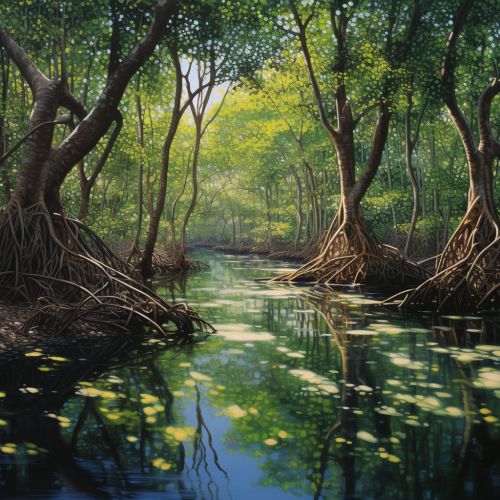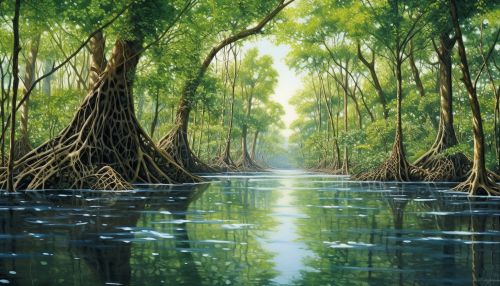The Ecology of Mangrove Forests
Introduction
Mangrove forests are unique ecosystems that are situated along the coastlines in tropical and subtropical regions. They are characterized by the presence of a diverse range of mangrove tree species, which are salt-tolerant and can thrive in harsh coastal conditions. These forests play a crucial role in the biodiversity of the planet, providing a habitat for a variety of marine and terrestrial species.
Characteristics of Mangrove Forests
Mangrove forests are distinguished by their dense network of roots, which extend both above and below the waterline. These roots, known as pneumatophores, allow the mangrove trees to breathe in the oxygen-deficient mud in which they grow. They also serve as a physical barrier against wave action, helping to prevent coastal erosion.


The trees in mangrove forests have a number of adaptations that enable them to survive in their unique environment. For instance, they have specialized glands on their leaves that excrete excess salt, and their seeds germinate while still attached to the parent tree, a phenomenon known as vivipary.
Biodiversity in Mangrove Forests
Mangrove forests are rich in biodiversity, providing a habitat for a wide range of species. They serve as breeding grounds for many species of fish and crustaceans, and are home to a variety of bird species. In addition, they provide a habitat for numerous species of insects, reptiles, and mammals.
The biodiversity of mangrove forests is closely linked to their structural complexity. The dense network of roots provides a safe haven for juvenile fish and invertebrates, while the canopy provides nesting sites for birds. The leaf litter and detritus that accumulate in the forest floor provide a rich source of nutrients for a variety of decomposer organisms.
Ecological Role of Mangrove Forests
Mangrove forests play a crucial role in maintaining the health of the planet's ecosystems. They act as a buffer zone between land and sea, helping to protect coastal areas from storm surges and tsunamis. They also play a key role in preventing coastal erosion by stabilizing sediments with their root systems.
In addition to their role in coastal protection, mangrove forests are also important carbon sinks. They sequester carbon at a rate two to four times greater than mature tropical forests, and store three to five times more carbon per equivalent area. This makes them a critical component in efforts to mitigate climate change.
Mangrove forests also contribute to the productivity of coastal waters. They trap and cycle nutrients and organic matter, enhancing the productivity of adjacent coastal waters. This in turn supports fisheries and contributes to food security in many tropical and subtropical regions.
Threats to Mangrove Forests
Despite their ecological importance, mangrove forests are under threat worldwide. The main threats to these ecosystems include deforestation due to aquaculture, agriculture, and urban development, pollution from industrial and domestic waste, and climate change.
Deforestation for aquaculture, particularly shrimp farming, is one of the leading causes of mangrove loss. This not only results in the loss of habitat for a variety of species, but also leads to a decrease in the forests' ability to sequester carbon, exacerbating climate change.
Pollution, particularly from industrial and domestic waste, can have devastating effects on mangrove forests. Excess nutrients from waste can lead to eutrophication, causing a decline in water quality and leading to the death of mangrove trees.
Climate change poses a significant threat to mangrove forests. Rising sea levels can lead to increased salinity, which can be detrimental to many mangrove species. In addition, changes in temperature and precipitation patterns can affect the health and distribution of these forests.
Conservation of Mangrove Forests
Efforts are being made worldwide to conserve and restore mangrove forests. These efforts include the establishment of protected areas, the implementation of sustainable forestry practices, and the restoration of degraded forests.
Protected areas can help to safeguard mangrove forests from deforestation and other threats. However, for these areas to be effective, they need to be properly managed and enforced.
Sustainable forestry practices can help to ensure that mangrove forests are used in a way that is ecologically sound and economically viable. This includes practices such as selective logging, which minimizes damage to the forest ecosystem, and the use of silviculture techniques to enhance the growth and productivity of the forest.
Restoration of degraded mangrove forests is also a key component of conservation efforts. This involves the replanting of mangrove trees in areas where the forest has been destroyed or degraded. However, for restoration efforts to be successful, it is important to take into account the specific ecological requirements of the mangrove species being planted.
